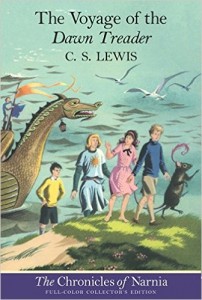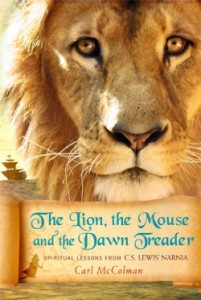Carl McColman: C. S. Lewis, Brendan the Navigator, and Evelyn Underhill
In March I was one of several presenters at a symposium on C. S. Lewis and Joy Davidman sponsored by Brenau University and Grace Episcopal Church in Gainesville, GA. The theme of the symposium was "Love Letters to Jack, Love Letters to God." Here is the transcript of my talk, in which I weave together my love for C. S. Lewis - especially the Narnia stories - with two influences on him: Evelyn Underhill and St. Brendan the Navigator.
Did "The Problem of Pets" Inspire Aslan?
Our theme this weekend is "love letters" so I would like to begin with an interesting letter that was written in 1940 to CS Lewis, from the noted Anglican laywoman and scholar of Christian spirituality, Evelyn Underhill.
Underhill, who lived from 1875 to 1941, was the leading English author on Christian mysticism in her day. Indeed, her book Mysticism: A Study in the Nature and Development of Spiritual Consciousness, published in 1911, is widely regarded as a classic treatment of that subject.
She and Lewis corresponded several times before her passing.
"The Letters of Evelyn Underhill," in which she scolds C. S. Lewis for his attitude toward animals
Several of Underhill's letters to Lewis are preserved in The Letters of Evelyn Underhill, published shortly after her death. These letters reveal that Lewis sent her at least two of his books, which she read and offered him discerning feedback.
The correspondence is for the most part very warm. In 1938, Underhill praises Out of the Silent Planet, even though she admits to having a "decided prejudice" against science fiction. She lauds him for "the fact that you have turned 'empty space' into heaven!"
Two years later, though, when commenting on The Problem of Pain, Underhill not only takes issue with one aspect of the book, but she positively scolds Lewis about it. He made a comment in the book about animals, which clearly angered Underhill.
Apparently, in 1940 Lewis seemed to think that wildness was a bad thing; in other words, he seemed to think that animals were brought nearer to God by being domesticated by human beings. He wrote,
The tame animal is in the deepest sense the only natural animal... the beasts are to be understood only in their relation to man and through man to God.
For Evelyn Underhill, this is beyond just a stupid idea. To her, these were fighting words. And she did not shrink back from the challenge. I can only quote part of her reply, because of how long it is. But like I said, she scolds. She writes:
This seems to me frankly an intolerable doctrine and a frightful exaggeration of what is involved in the primacy of man. Is the cow which we have turned into a milk machine or the hen we have turned into an egg machine really nearer the mind of God than its wild ancestor?
She is just getting warmed up. She invokes William Blake as she continues her tirade.
You surely can't mean that, or think that the robin redbreast in a cage doesn't put heaven in a rage but is regarded as an excellent arrangement. Your own example of the good-man, good-wife, and good-dog in the good homestead is a bit smug and utilitarian, don't you think, over against the wild beauty of God's creative action in the jungle and the deep sea? And if we ever get a sideway glimpse of the animal-in-itself, the animal existing for God's glory and pleasure and lit by His light (and what a lovely experience that is!), we don't owe it to the Pekinese, the Persian Cat or the canary, but to some wild free creature living in completeness of adjustment to Nature a life that is utterly independent of man. And this, thank Heaven, is the situation of all but the handful of creatures we have enslaved.
She goes on, and makes a theologically nuanced argument about how humankind and the natural world may relate to the each other in the light of salvation. But she points out that humanity's role in the "redemption and transfiguration" of the animal world will come about not through taming animals: "Rather by loving and reverencing the creatures enough to leave them free."
Great writer that she is, she finishes her argument with a brilliant final point.
Perhaps what it all comes to is this, that I feel your concept of God would be improved by just a touch of wildness.
When Lewis replied, his letter is by turns defensive, charming, and conciliatory, without much insight into how Underhill's perspective may have influenced his thinking.
But I can't help but engage in a delicious bit of speculation.
"The Lion, the Witch and the Wardrobe," in which Lewis introduces the "not-tame" Aslan.
Underhill wrote the letter I've just quoted in January 1941, just months before she died. Less than a decade went by before Lewis wrote the first of his seven Narnia books, The Lion, the Witch and the Wardrobe.
Today it is probably his best known book, no thanks to the continued popularity of the Narnia series as a whole. But it is in The Lion, the Witch and the Wardrobe that readers were first introduced to Aslan, the noble Lion who symbolizes Christ himself.
And in one of the most memorable passages in that book, the Pevensie children from England first learn about Aslan from a pair of talking Beavers:
"I tell you he is the King of the wood and the son of the great Emperor-beyond-the-Sea... Aslan is a lion- the Lion, the great Lion."
"Ooh!" said Susan, "I'd thought he was a man. Is he- quite safe? I shall feel rather nervous about meeting a lion."
"That you will, dearie, and no mistake," said Mrs. Beaver; "if there's anyone who can appear before Aslan without their knees knocking, they're either braver than most or else just silly."
"Then he isn't safe?" said Lucy.
"Safe?" said Mr. Beaver; "don't you hear what Mrs. Beaver tells you? Who said anything about safe? 'Course he isn't safe. But he's good. He's the King, I tell you."
Then, almost at the very end of the story, when Aslan silently departs from Narnia in the midst of a great celebration, the conversation with the Beavers is recalled.
Mr. Beaver had warned them, "He'll be coming and going ," he had said. "One day you'll see him and another you won't. He doesn't like being tied down- and of course he has other countries to attend to. It's quite all right . He'll often drop in. Only you mustn't press him. He's wild, you know. Not like a tame lion."
Aslan is not safe - because he's wild, you know. Not like a tame lion. I think Evelyn Underhill would have heartily approved, had she still been alive when this story was published.
I suppose we'll never know for sure if Underhill's passionate defense of wild animals directly inspired C. S. Lewis when he sat down a few years later to unleash Aslan in the Narnia stories. But I like to hope and think that maybe her words were an inspiration to him.
At any rate, we are all the richer for the insight and imagination that went into the telling of the Narnia stories. And Evelyn Underhill's letter would bring a smile to any animal lover's face.
From the Lion to the Mouse
"The Voyage of the Dawn Treader," in which C. S. Lewis updates the Brendan story.
Now I'd like to turn our attention to the third of the Narnia books, The Voyage of the Dawn Treader published in 1952. It is the "odyssey" of Narnia, a story of an adventure at sea, in which the good king Caspian, joined by three English schoolchildren, voyages across the eastern sea in search of seven lost lords from his father's court.
But as the story unfolds, we soon learn that a passenger on the Dawn Treader, the valiant Reepicheep the Mouse, has an even more noble quest at heart - to travel beyond the end of the world, to Aslan's country itself.
For us to fully appreciate this adventure, I believe we need to look back over a thousand years, to a medieval Celtic legend called The Voyage of Saint Brendan the Navigator. In one of his notebooks, Lewis himself describes the sources for The Voyage of the Dawn Treader as "the Odyssey and St. Brendan."
The Voyage of St. Brendan is about as close you can get to a medieval bestseller. Over 100 manuscript copies of the text have been preserved, showing that it was widely copied, and we may assume widely read, in medieval times.
The story of Brendan belongs to a genre of Celtic literature called the Immrama, or the "wondrous sea voyages." Many such tales extend all the way back into pagan mythology, where god-like figures with exotic names such as Bran the Blessed or Mael Duin set sail from the west coast of Ireland, heading out over the boundless sea in search of an earthly paradise.
Indeed, some scholars speculate that the ancient Irish seafarers may have made it all the way to Greenland or even Newfoundland, which would make them, not Leif Erikson or Christopher Columbus, the first Europeans to reach North America.
But I digress.
"The Voyage of Brendan" - a chief inspiration for the Dawn Treader
Unlike its pagan counterparts, The Voyage of St. Brendan the Navigator is a thoroughly Christian tale; its protagonist is not a pagan god, but the abbot of a Christian monastery.
One day a friend of Brendan's visits his cloister and announces that he has sailed west, all the way to the land of promise - in other words, to paradise itself.
Brendan, not surprisingly, is entranced by this news, and after considering the matter in his own prayers, resolves to sail himself, with several of his monks as companions, in their own quest for this earthly paradise.
And thus begins a charming, if fantastic, tale of visiting a variety of islands over the course of seven years at sea, many of which are inhabited by monks (of course), while others feature a choir of birds who chant the psalms, an uninhabited island where nevertheless a mystical hospitality occurs, providing food for the voyagers, and various other unusual settings.
Along the way, Brendan and his company have narrow escapes from whales and sea serpents, find the very mouth of hell itself, and have an encounter with none other than Judas Iscariot, whom they find chained to a rock in a stormy sea, where he is lashed by waves every Sunday - this is his sabbath rest, after enduring the fires of hell the other six days of each week.
Finally, Brendan and his company reach the very island of paradise itself, filled with glittering jewels, abundant fruit, and an angel who turns them back noting that they must return to Ireland to live out the rest of their mortal lives, before finally returning to the Promised Island for all eternity.
Narnia fans: does this sound familiar?
Despite significant differences between The Voyage of St. Brendan and The Voyage of the Dawn Treader, the similarities in both plot and detail are so numerous that we could argue that C. S. Lewis has actually made his own, 20th-century contribution, to the literature of the Immrama.
This contention is strengthened when we consider that The Voyage of St. Brendan serves not merely as some sort of amusing medieval adventure, but in fact represents an allegorical tale of monastic formation and growth in the Christian spiritual life.
Monastic values such as obedience, humility, hospitality, the recitation of daily prayer, the chanting of psalms, observance of the liturgical year, all form the skeleton of Brendan's adventure. It's a grand metaphor for earthly life, which may be seen as a voyage from birth to death.
By joining Brendan in the "ship" of his monastery, those who seek the paradise of heavenly promise are offered passage, in the context of prayer and monastic life.
Now, C. S. Lewis was no monk, and had no reason to write a morality tale based on the virtues of the cloistered life. But we know from a letter he wrote to a schoolgirl named Anne Jenkins in 1961 that he did consider The Voyage of the Dawn Treader to be an illustration of the lifelong project of Christian spirituality.
In that letter (found in The Collected Letters of C.S. Lewis Volume III), Lewis remarks that The Voyage of the Dawn Treader depicts "the spiritual life (specially in Reepicheep)."
The Dawn Treader and the Mystical Life
My humble book about Narnia
Let us return for a moment to Evelyn Underhill, who wrote that the Christian mystical life consists in five stages: awakening, purification, illumination, the dark night of the soul, and union with God.
This map, or itinerary, of the spiritual life did not originate with Underhill; rather, she builds her developmental description of the mystical life on a classic three-fold formulation of spiritual growth, consisting of purgation, followed by illumination, leading to union.
This threefold way can be traced back at least as far as the third century, as it is developed by Origen of Alexandria, who died circa 254.
This map corresponds precisely to the plot of The Voyage of the Dawn Treader, although not all of the action concerns Reepicheep the mouse.
Eustace, the ill-mannered English school boy, provides the context of how Lewis depicts both the spirituality of awakening and purification, whereas Lucy's adventures on an island of silence illustrates the spirituality of illumination, culminating in an appearance by Aslan himself.
The entire ship visits an island enshrouded in darkness, Lewis's way of depicting the dark night of the soul.
After the Eucharistic symbolism on the Island of the Three Sleepers, some of the most beautiful prose in the Narnia books - arguably, throughout Lewis's entire corpus - describes the Dawn Treader's voyage into a silver sea filled with silence and light, culminating - for Reephicheep alone - in the final voyage to Aslan's country itself, representing the ultimate beatitude of union with God.
So what can we take away from all this?
Simply put, when we consider how richly C. S. Lewis drew from the Christian contemplative and mystical tradition - whether we are talking about the classical itinerary of the mystical life, the rich mythology of the Celtic monks, or even the winsome scolding he received from his correspondent Evelyn Underhill, we realize that, in addition to being a gifted literary critic, lay apologist, poet, and storyteller, C. S. Lewis was a mystagogue - a fancy word that means someone who leads others into the mystery of faith.
What a privilege it is for us, on the 65th anniversary of The Voyage of the Dawn Treader, to be led by so wise a guide.
N.B. If you want to learn more about my perspective on the spirituality of Narnia, check out my book The Lion, the Mouse and the Dawn Treader: Spiritual Lessons from C. S. Lewis's Narnia.





